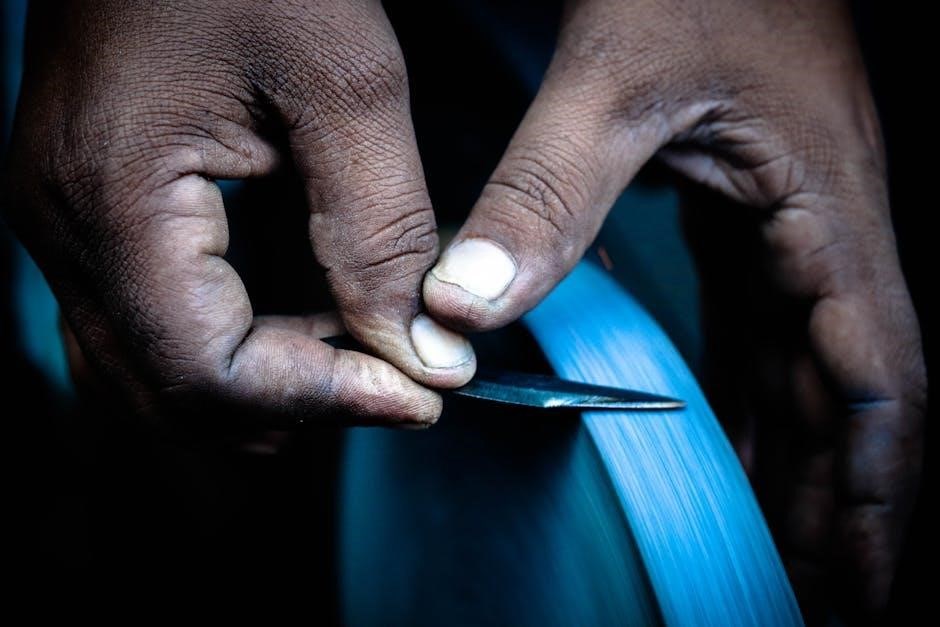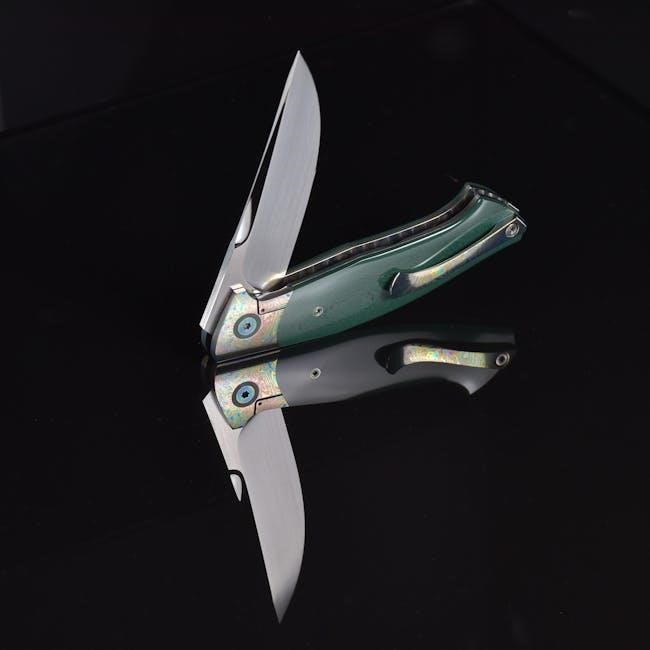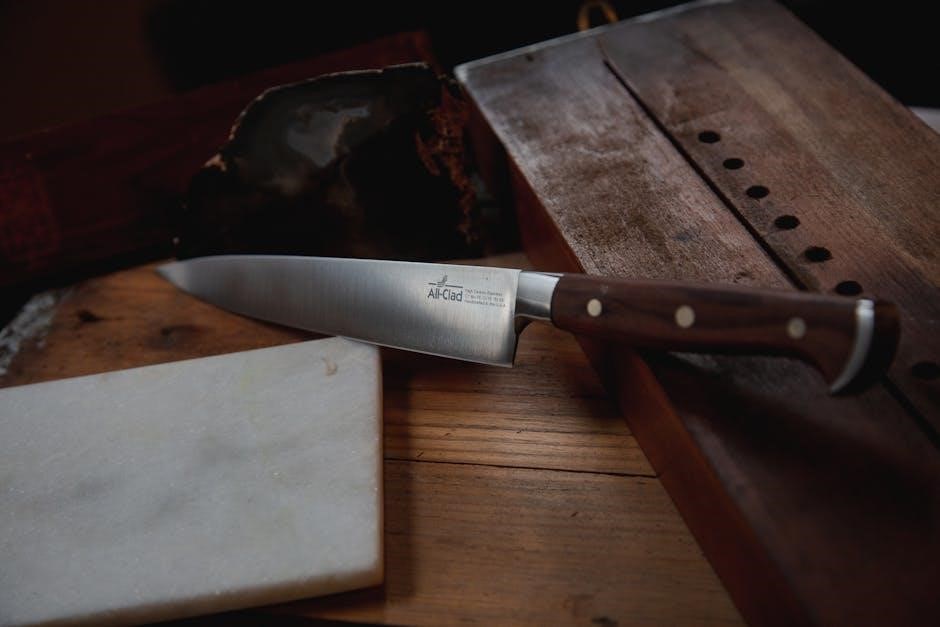Welcome to the ultimate knife angle sharpening guide! This resource provides essential knowledge for achieving razor-sharp edges on your blades. Learn about selecting the correct angle to effectively sharpen your dull knives, helping you maintain optimal cutting performance for safety and efficiency.
Understanding knife sharpening angles is crucial for maintaining the performance and longevity of your blades. The angle at which you sharpen a knife directly influences its sharpness, edge retention, and overall cutting ability. Different knives require specific sharpening angles tailored to their intended use, steel hardness, and blade geometry. Mastering sharpening angles is essential for both culinary enthusiasts and professionals alike. This guide will provide the knowledge to choose and maintain the appropriate angles.

Understanding Sharpening Angles
Sharpening angles are critical to a blade’s performance. Choosing the correct angle impacts sharpness and durability. This section explains what sharpening angles are and why selecting the right one is essential for effective knife maintenance.
What is a Sharpening Angle?
A sharpening angle refers to the angle formed between the knife’s blade and the sharpening surface, such as a whetstone or sharpening steel. It is measured in degrees and determines the geometry of the cutting edge. The correct angle ensures the blade is sharpened effectively, creating a keen and durable edge. Different knives require different sharpening angles depending on their intended use and blade material. Maintaining this angle consistently during sharpening is crucial for achieving optimal results. The total angle is bisected, so each side is half of the total sharpening angle.
Importance of the Correct Sharpening Angle
Using the correct sharpening angle is vital for achieving optimal sharpness and edge retention on your knives. An incorrect angle can result in a dull edge that is prone to damage or a weak edge that quickly loses its sharpness. Selecting the appropriate angle based on the knife type, steel hardness, and intended use will maximize cutting performance and extend the lifespan of the blade. Consistently maintaining the correct angle during sharpening ensures a uniform and effective cutting edge, improving both safety and efficiency in use. Sharpening at the wrong angle can ruin a blade.
Factors Influencing Sharpening Angle Selection
Selecting the right sharpening angle depends on several factors. These include the knife’s intended use, the type of steel, and its hardness. Understanding these elements ensures the blade is sharp and durable for its specific tasks.
Knife Type and Intended Use
The type of knife and its intended use are critical in determining the appropriate sharpening angle. Kitchen knives, used for slicing and dicing, typically benefit from a 15-20 degree angle. Hunting and tactical knives, designed for tougher tasks, usually require a more robust 25-40 degree angle. Japanese knives, known for their precision, also utilize a 15-20 degree angle. Selecting an angle that matches the knife’s purpose ensures optimal cutting performance and durability, enhancing both efficiency and safety during use, especially when dealing with various materials.
Steel Hardness (HRC) and Edge Retention
Steel hardness, measured on the Rockwell scale (HRC), significantly impacts edge retention and the appropriate sharpening angle. Harder steels (58-62 HRC) can hold a finer edge and often benefit from a lower sharpening angle (15-20 degrees) for precision cutting. Softer steels (52-56 HRC) may require a slightly higher angle (20-25 degrees) to prevent the edge from rolling or chipping. Matching the sharpening angle to the steel’s hardness ensures a balance between sharpness and durability, optimizing the knife’s performance and longevity during various tasks while minimizing frequent resharpening.
Common Sharpening Angles for Different Knives
Different knives require specific sharpening angles for optimal performance. Understanding these common angles is crucial for maintaining the edge and extending the life of your knives, whether they are kitchen, hunting or tactical knives.
Kitchen Knives (Chef’s Knife, Paring Knife) ⎼ 15-20 degrees
Kitchen knives, including chef’s knives and paring knives, typically benefit from a sharpening angle between 15 and 20 degrees. This range offers a balance between sharpness and durability, suitable for the varied tasks performed in the kitchen. A 15-20 degree angle can ensure efficient slicing and chopping while maintaining edge retention. These knives, used for everyday food preparation, require a keen edge to handle vegetables, fruits, and meats with precision. A sharper angle is ideal for kitchen knives.
Hunting and Tactical Knives ⎼ 25-40 degrees
Hunting and tactical knives require a more robust edge due to their demanding applications, thus a sharpening angle of 25 to 40 degrees is generally recommended. These knives are often used for tougher tasks such as cutting through dense materials, game processing, and survival situations. The wider angle provides increased durability and resistance to chipping or rolling, ensuring the knife maintains its functionality under heavy use. This angle sacrifices some sharpness for enhanced edge retention and strength, crucial for field conditions.
Japanese Knives ⎼ 15-20 degrees
Japanese knives, known for their exceptional sharpness and precision, typically require a sharpening angle between 15 and 20 degrees. This acute angle allows for incredibly fine and clean cuts, making them ideal for delicate tasks like filleting fish or preparing sushi. However, this sharper edge is also more delicate and prone to chipping if not properly maintained. Due to harder steel, Japanese knives can maintain this acute edge longer, provided that the user sharpens the blade at a consistent angle.

Methods for Measuring Sharpening Angles
Accurately measuring your sharpening angle is crucial for achieving a consistent and effective edge. Several methods exist, from using simple tools like protractors to employing advanced sharpening systems with built-in angle guides for precision.
Using a Protractor and Scissors Method
A simple yet effective method for approximating a sharpening angle involves using a protractor and a pair of scissors. Open the scissors and insert the knife blade between the blades. Adjust the scissors until the blade aligns with the desired angle on the protractor. This provides a visual reference for maintaining the correct angle while sharpening. Remember to maintain consistent pressure and replicate this angle on the sharpening stone for optimal results.
Angle Guides and Sharpening Systems
For more precise angle control, consider using angle guides or dedicated sharpening systems. Angle guides are typically small tools that attach to the knife blade, providing a consistent angle against the sharpening surface. Sharpening systems often include a jig or clamp to hold the knife at a predetermined angle. These systems remove the guesswork, ensuring consistent and repeatable sharpening results, especially beneficial for beginners or those seeking professional-level sharpness.
Maintaining a Consistent Angle During Sharpening
Maintaining a consistent sharpening angle is crucial for achieving a sharp and durable edge. Consistency ensures even wear and prevents uneven bevels, leading to optimal cutting performance and prolonged blade life, making your knives always ready.
Importance of Consistency for Edge Quality
Maintaining a consistent angle during knife sharpening is extremely important for achieving a high-quality edge. When the angle varies, the blade sharpens unevenly, leading to a weak and less effective cutting edge; Consistency ensures that the entire bevel meets the sharpening stone uniformly, creating a sharp and durable edge. A uniform edge improves cutting precision and reduces the need for frequent sharpening, ultimately extending the life of your knife. Consistent sharpening also builds muscle memory, making future sharpening sessions more efficient and effective.
Techniques for Maintaining Angle (Visual Cues, Muscle Memory)
Maintaining a consistent angle during sharpening requires practice and attention to detail. Visual cues can guide you, such as observing the reflection of light on the bevel. Focus on keeping this reflection uniform as you move the blade. Muscle memory develops over time with repeated practice. Start slow, paying close attention to the feel of the blade against the sharpening stone. Use angle guides initially to train your hand, gradually relying less on them as your muscle memory improves. Consistent practice ensures a sharp, even edge.
Tools for Knife Sharpening
Selecting the right tools is crucial for effective knife sharpening. This section explores various sharpening tools, including sharpening stones of different types and grits. We will also consider the pros and cons of electric knife sharpeners for your sharpening needs.
Sharpening Stones (Types and Grits)
Sharpening stones are essential tools for achieving and maintaining a sharp knife edge. They come in various types, each suited for different purposes. These types include water stones, oil stones, and diamond stones. Each one has its unique characteristics and requirements for use.
Grit refers to the abrasiveness of the stone. Coarse grits are for repairing damaged edges. Medium grits are for general sharpening. Fine grits are for refining and polishing the edge to razor sharpness. Selecting the right grit is crucial for effective sharpening.
Electric Knife Sharpeners (Pros and Cons)
Electric knife sharpeners offer a convenient way to sharpen knives quickly and easily. Pros: They provide consistent angles, speed up the sharpening process, and are user-friendly. This makes them ideal for beginners. Cons: Electric sharpeners can sometimes remove too much metal. This reduces the lifespan of the knife and may not achieve the same level of sharpness as manual methods. They can be expensive, and some models are not suitable for all knife types.

Sharpening Techniques
Mastering proper sharpening techniques is crucial for maintaining your knives. Whether using a traditional stone or an electric sharpener, correct technique ensures blade sharpness. With the right method, you can achieve professional-quality edges.
Sharpening with a Stone
Sharpening with a stone requires practice and patience, but offers superior control. First, lubricate the stone with water or oil. Maintain a consistent angle, typically between 15-20 degrees for kitchen knives, and move the blade across the stone. Use overlapping strokes, working from heel to tip. Flip the blade and repeat on the other side, ensuring even sharpening. Check sharpness by slicing paper. Refine edge by using progressively finer grits. This method helps achieve a razor-sharp edge tailored to the knife’s intended use.
Sharpening with an Electric Sharpener
Electric knife sharpeners offer convenience and speed, but require caution. Select the appropriate angle setting for your knife type, typically between 15-20 degrees for kitchen knives. Pass the blade through each sharpening stage as directed by the manufacturer, maintaining light pressure. Be cautious not to overheat the blade, which can damage the steel. Check edge sharpness after each stage and avoid over-sharpening. While easy to use, electric sharpeners may remove more material than manual methods, reducing knife lifespan if used excessively. Ensure proper maintenance to preserve their effectiveness.

Troubleshooting Sharpening Issues
Encountering problems while sharpening? This section addresses common issues like damaged blades or incorrect sharpening angles. Learn how to identify and correct these problems to achieve a sharp, durable edge and restore your knives to their optimal cutting condition.
Damaged or Chipped Blades
Addressing damaged or chipped blades requires a different approach. First, assess the extent of the damage to determine if repair is feasible. For minor chips, use a coarse grit stone to grind down the blade until the damaged area is removed, creating a new, even edge. Be careful to maintain the correct angle. More extensive damage may require professional repair or blade replacement to ensure safety and performance. Reshape carefully!
Incorrect Angle Sharpening
Sharpening at the wrong angle leads to a dull or weak edge. If the angle is too steep, the edge may become too thick and not cut efficiently. Conversely, if the angle is too shallow, the edge will be too thin and prone to chipping or rolling. To correct this, re-establish the appropriate angle using a coarse stone to remove the improperly sharpened material. Then refine the edge with finer grits for optimal sharpness and durability.
Safety Precautions
Always prioritize safety when sharpening knives. Use cut-resistant gloves to protect your hands. Maintain a stable grip on both the knife and the sharpening tool. Focus on the task to prevent accidents and injuries during the sharpening process.
Proper Handling of Knives and Sharpening Tools
Handling knives and sharpening tools requires careful attention to prevent injuries. Always maintain a firm, secure grip on the knife handle, keeping fingers away from the blade’s path. When using sharpening stones or electric sharpeners, ensure they are placed on a stable surface. Never rush the sharpening process; focus on each movement. Store knives and sharpening tools safely when not in use, away from children. Regularly inspect your tools for damage, replacing them as needed to ensure both safety and effectiveness during each sharpening session.
Preventing Cuts and Injuries
To avoid cuts and injuries, adopt a slow, deliberate approach when sharpening knives. Use cut-resistant gloves for added protection and always focus on the task. Keep a first-aid kit nearby. Ensure adequate lighting in your work area. Avoid distractions. Never place your fingers in the path of the blade while sharpening. If a knife slips, let it fall; do not attempt to catch it. Clean up any oil or water spills immediately to prevent slips. Seek professional medical attention for any cut sustained, no matter how minor.
Mastering knife sharpening angles ensures optimal cutting performance. By understanding angles, selecting appropriate techniques, and prioritizing safety, you can maintain razor-sharp edges. This enhances both efficiency and safety in all your cutting tasks, ensuring blades are always ready.
Recap of Key Concepts and Best Practices
Remember that the sharpening angle significantly impacts edge sharpness and durability. Typically, kitchen knives require 15-20 degrees, while hunting knives benefit from 25-40 degrees. Consistency is paramount; maintain your chosen angle throughout the sharpening process using visual cues or guides. Regularly sharpen knives to prevent excessive dulling, making the process easier and safer. Always prioritize safety, handling knives and tools carefully to avoid injuries. Sharp knives improve cutting performance and reduce the risk of accidents.
